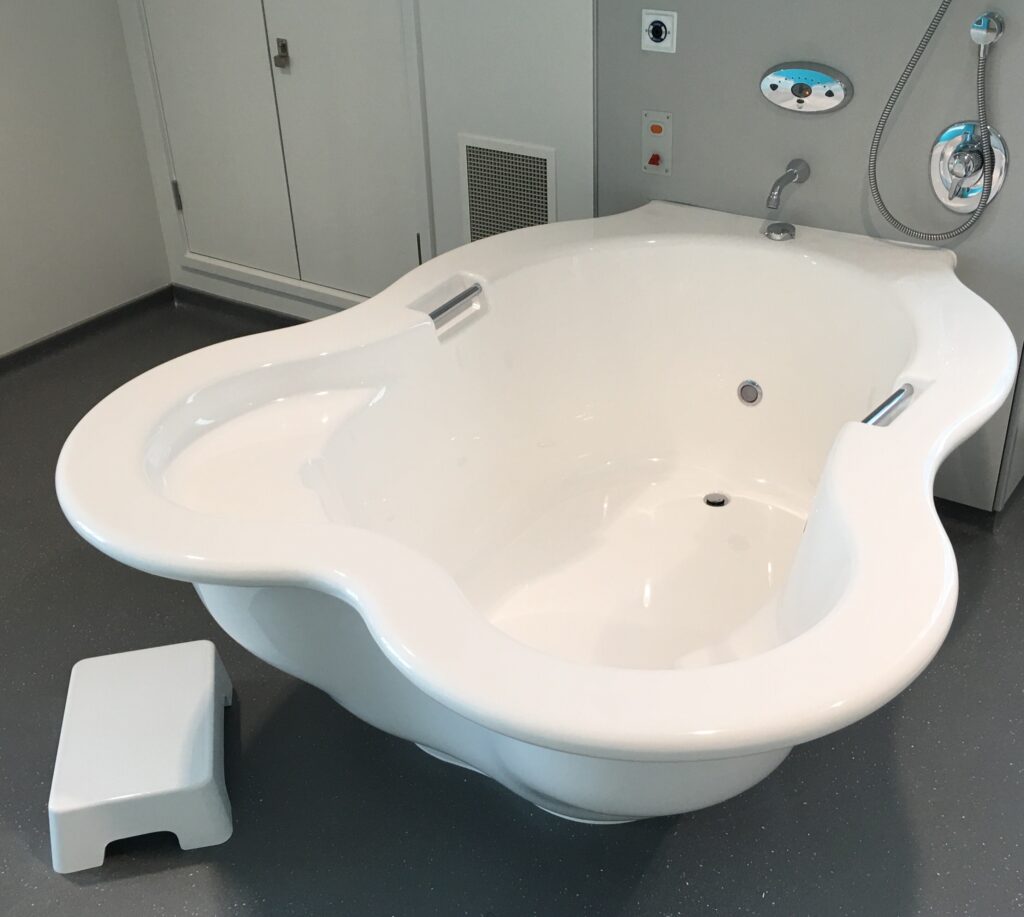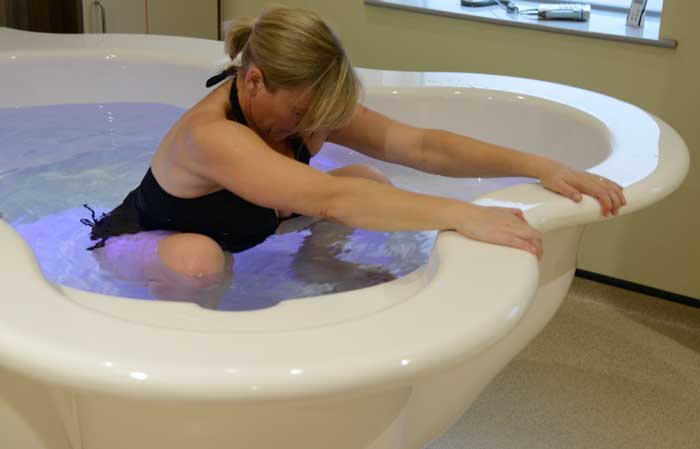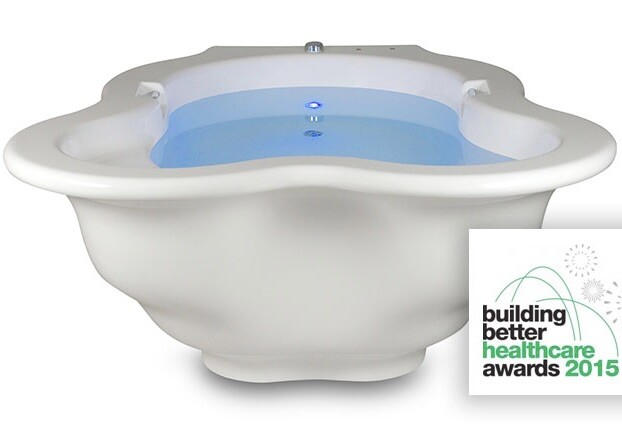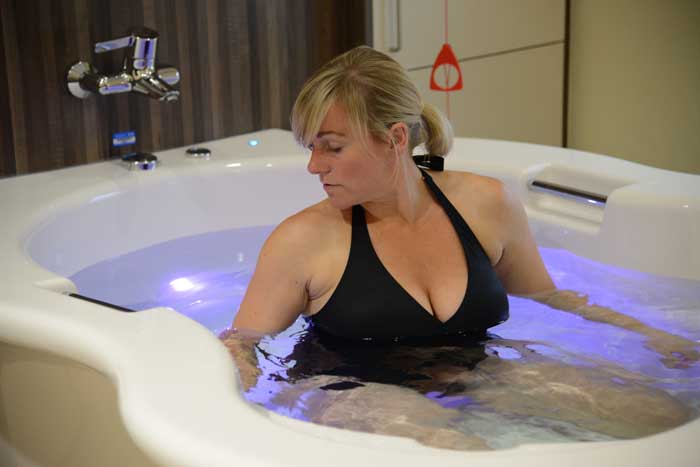Professional advice for attending midwives
1. Must be the midwives choice to help mothers in the pool room.
Two midwives present for delivery
2. Adequate education
- Literature
- Videos
- Regular study days and conferences
3. Professional and peer support
4. Familiarity with legal implications
(in UK code of practice 3.3.3. Sections C & D).
5. Record Keeping
- Annual analysis and evaluation of outcomes
6. Health and Safety
- Infection control (rubber gloves – half size smaller or gauntlets, immunization)
- Cleaning of the bath and equipment
- Electrical safety
7. Rehearse Emergency Procedures
- Ensure proximity to paediatric resuscitation and other medical aid. Familiarise procedure.
8. Midwife’s Comfort
- loose-fitting clothing
- theatre clothing useful
Preparation of Parents
Aqua natal and other antenatal classes
- Visit to pool room – rehearsal – 34 weeks +
- Review of literature – albums – photographs
- Leaflets and books
- Videos and discussion
- Meeting other parents who have used facility
Midwife explains use of the pool
Discuss:
- Expectations
- Birth plan
- Other forms of pain relief possible in conjunction with the pool (TNS, homoeopathy, aromatherapy).
- Music, camera etc
- Back-up
File notes of parent’s wishes
Parents to agree in advance
- The midwife will do her utmost to facilitate the parents wishes.
However
Midwife on duty must be competent and willing
Midwife’s judgement is paramount. If the midwife is not happy about aspects of progress in the pool and wants the mother to leave the pool, she will agree to do so.
“Midwives are accountable for their own practice”
PREPARING THE POOL ROOM
Portable Pool
1. Position the pool to allow easy access all the way round (consider trolley in an emergency).
Remove all unnecessary furniture.
2. Place blue disposable liner in position
3. Run tap for five minutes before filling the pool.
Put filling pipes over the side of the pool.
Fill pool two-thirds full – temperature 36-37 degrees C
As pool is filling, adjust creases in liner.
4. Maintain temperature to mother’s comfort between 32 and 37 degrees.
With this amount of water, temperature reduces at about 1 degree per hour – check half-hourly). Keep heat retaining cover on pool when not being used.
5. Clean up any spillage – remove unnecessary hose.
6. Equipment Required
- Clean sieve to remove faecal debris
- Electric fan – especially in warm weather
- Cassette player
- Good supply of bath towels and robe
- Non-slip mat
- Waterproof sonic aid for monitoring or Pinnard stethoscope
- Candles or essential oils, homoeopathic remedies
- A large jug or cold water for drinking
- Inflatable cushions, rubber ring etc.
- Easy access to resuscitaire heater in room or outside
- Ensure that facilities for ‘land’ birth are available in room ie: mattress or delivery bed, stool, chair, non-slip mat, beanbag.
- Call system and telephone location known
- Water and room thermometer, delivery pack,
- Syntometrine, Lignocaine etc.
Parents’ birth plan
Admission
1. Confirm mother still wishes to use the pool
2. Base line observations
- Temperature
- Pulse
- Blood Pressure
- Urine
- Palpatation – presentation and lie
3. Assess strength of contractions
4. Obtain satisfactory CTG
5. Vaginal assessment
Avoid rupture of membranes
AIM – Physiologically normal labour
6. Glycerine suppositories – some offer microlax enema (5 mls). This is not usually necessary.
7. Encourage mother too remain outside pool until mid-labour.
Use:
- TNS
- TLC
Aromatherapy Massage
- Lavendar
- Jasmine
- Clary Sage
Homoeopathy
- Arnica 200 (pain)
- Aconite 200 (fear)
- Pulsatilla 200 (weepy)
- Kali Phos 200 (exhaustion)
- Caulophyllum 200 (ineffectual contractions)
Labour – Inclusion criteria
- Term Babies only 37 -43 weeks
- Cephalic presentation established in labour
- Spontaneous rupture of membranes if contracting
- Induction by vaginal PGE
- Good progress
- Previous caesarian
- Twin babies
Labour – Exclusion criteria
- Foetal distress
- Fresh meconium-stained liquor
- Intra-uterine growth retardation
- Babies at risk
- Ante-partum haemorrhage
- Previous post-partum haemorrhage (?)
- Intravenous infusion
- Severe pre-eclampsia or raised blood pressure
- Epilepsy
- Skin conditions
- Known Hepatitis or positive HIV status
- Sedation
- Poor progress
- Breech
Caring for the mother and baby in the pool
Labour
Priority – remember too many interruptions breaks the mother’s concentration.
Disturb as little as possible
1. Labour established prior to mother’s entry to pool (4cm onwards)
2. Mother can adopt any position she likes. Frequent changes are good.
3. Adjust depth of water for comfort
4. Lower lights
5. Midwife in constant but discrete attendance while mother is in the pool.
6. Check water temperature regularly Mother comfortable – not too warm or too cold 36-37 degrees at delivery
7. Ensure plenty of fluids – mother, partner and staff – to prevent dehydration.
8. Ventilation and room temperature to comfort.
Observations during Labour
- Maternal and foetal, as usual
- Maternal temperature and pulse (2 hourly)
- Blood pressure (4 hourly)
- Foetal heart (half hourly)
- Vaginal (4 hourly, or at midwife’s discretion)
- In any position Mother standing up
- With partners help – float mother to surface, partner supports her under pelvis
Amniotomy
Usually unnecessary, membranes left intact as long as possible, but can be performed in water.
Pain Relief
1. Warm water may be enough
2. Breathing, visualization, relaxation techniques
3. Massage – holding – partner in pool optional (bathing trunks to be worn)
4. Homoeopathy
5. Essential oils by inhalation – Lavendar, Clary Sage or Marjoram
6. Verbal support – partner participation
7. Opitons – N20 + 02 (Entenox) – Pethidine (not to exceed 50 mgm)
Elimination
1. Inclusion of toilet in pool room preferable
2. Mother usually empties her bladder without being aware of it.
Birth in water
Exclusion Criteria
- Foetal distress
- Premature babies (37 –38 weeks)
- Post mature babies (42 – 43 weeks)
- Prolonged second stage or poor progress
- Mother needs to be grounded – no power
- Twins – multiple births
- Breech presentation
- Possible shoulder dystocia – baby large in proportion to mother
- Water unusually dirty
- Previous Caesarean section
Second Stage in the pool
If contractions slow down in second stage, the mother should leave the pool – if contractions are effective birth may occur under water.
Two midwives present
Second stage initiation usually self-evident. Vaginal examination not necessary as a routine.
Guidance, support – sometimes suggest different position. Do not actively encourage pushing if progress is normal. (if progress is not satisfactory – advise mother to deliver on dry land).
Crowning: manual support of perineum and control of head not usually needed, due to softening effects of water.
Baby born from front. Head delivered – with next contraction body is delivered. Slowly raise the baby to the surface of the water without delay. Baby face up under water, face down when lifted up. Mother assists or is given baby and welcomes baby with head above water but body below water to minimize heat-loss by evaporation (water level may need adjustment so mother can sit comfortably and hold baby like this)
Baby born from behind into water. Do not bring baby to surface from behind mother. Pass baby, face up, through mother’s legs and invite mother to reach down and receive the baby herself and then hold the baby’s head above, body below water surface level.
If mother stands up or baby is born above the water surface, ensure that the head does not resubmerge. Pass baby to mother (between the legs if from behind), she can then sit down in the pool with baby’s body submerged and head above the water level.
Midwife checks apex beat and cord pulsation, Apgar and blood loss observation.
Mother and father welcome baby, take photographs etc.
First sucking takes place.
Third stage in water
Exclusion Criteria:
- Heavy Blood loss (> 500 mls)
- Mother feels faint
- Delayed delivery of placenta
- Baby needs resuscitation
First contact between mother and baby undisturbed if possible.
Discreet, unhurried observations
Placenta:
- In water? Out of water?
- Theoretical risk of water embolism (no actual case reported).
- Privacy maintained for optimal oxytocin secretion
- Room temperature raised
- Mother helped out of pool
- Offered warm robe or towels
- Baby suckling encouraged
- Mother sitting upright – supported
- Placenta expelled – using squatting position if necessary
A physiological third stage is logical after a natural birth.
Use oxytocic drugs only if blood loss is excessive
- After delivery inspect placenta and perineum for trauma
- Suturing best done one hour after leaving pool to allow recovery from the effects of saturation.
- Check uterus is well-contracted and blood loss is not excessive
- Leave mother comfortable with baby.
Emptying a portable pool
- Place pump in the pool
- Hose to suitable outlet – ensure end is securely anchored
- Start pump – takes about 20 minutes
- Dispose of last gallon with liner
Dealing with Emergencies
If in doubt – Get her out!
Cord around neck
- No need to feel for cord after delivery of head.
- If cord entanglement – loosen, slip over baby’s head or body after delivery
- In rare instance of needing to cut the cord, ask mother to stand up. Once rest of the baby is delivered, mother may sit back into the pool and welcome the baby as usual.
Remember: NEVER cut the cord prior to underwater delivery
Once out of water, the baby’s head must not be allowed to resubmerge, as breathing may have initiated already.
Shoulder dystcoia
- Try to exclude potential shoulder dystocia prior to onset of second stage in water.
- Stand mother up out of water
- Call for assistance and paediatrician
- Ask mother to bend over and grip side of the pool, standing with legs well apart.
- The midwife will have to step into the pool and work from behind the mother
- An emergency episiotomy may have to be performed. Give traction towards mother’s back to release anterior shoulder.
- In most cases of dystocia this should be effective, if shoulder in the anterior / posterior position.
- If on palpation the baby feels excessively large, then perhaps it would be advisable for the mother to labour in the pool only, and deliver on dry land. Certainly ask mother to leave the pool if progress is slow with a large baby in second stage.
Episiotomy Procedure
Episiotomy is rarely needed for a water birth
Only done if baby is stuck or in an emergency where mother cannot leave the pool.
Not difficult to do in the pool
- Change mother’s position – across the pool, partner supporting her shoulders
- Float mother up so perineum is just under the surface (if local anaesthetic is used, ask mother to sit up on the edge of the pool for a minute or too while it is administered,
- With perineum under the water surface, two fingers of left hand between head and perineum – line up scissors.
- At height of next contraction – cut
- Mother sinks deeper into the pool
- Head delivered
Woman Collapsing in Pool
(this rarely happens if guidelines are observed)
Call for assistance.
Do not empty pool – if possible fill to maximum as buoyancy aids removal of mother from pool.
If partner is present, ask him to support woman but do not lift.
Midwife maintains airway until assistance arrives.
Assistance Arrives
- State ‘Pool Emergency’ – summon further help – minimum three people, ideally four (team leader coordinates procedure.
- Trolley – slide board, handling slings brought in. Tip head of trolley down and place at edge of pool. Slide board placed over edge of pool, bridging gap between pool and trolley.
- Two assistants enter pool – place handling slings under woman’s chest and buttocks. Third assistant supports head.
- Use buoyancy of water to float woman from pool to slide board to trolley
- Dry and cover woman and escort to delivery suite if necessary, giving appropriate emergency treatment. NB: check equipment regularly.
- Attend regular ‘lifting’ refresher courses with prior practice highly recommended for anyone atttending water labour or birth.
Baby slow to breathe
- It has been commonly observed that babies born underwater are very calm and initiation of breathing is usually slower.
- Blowing on baby’s skin stimulates breathing
- Suction of air passages can be carried out with mother holding baby in the pool.
- If further resuscitation is required, clamp and cut cord and take baby to resuscitaire. Clear airways and administer oxygen while summoning paediatrician. Keep warm and dry.
- All midwives should attend a course on advanced neonatal resuscitation.
Please note: This is copyrighted material. But you’re free to forward it to anyone you like, as long as you don’t make any changes or profit from its use.









